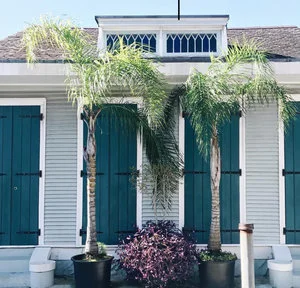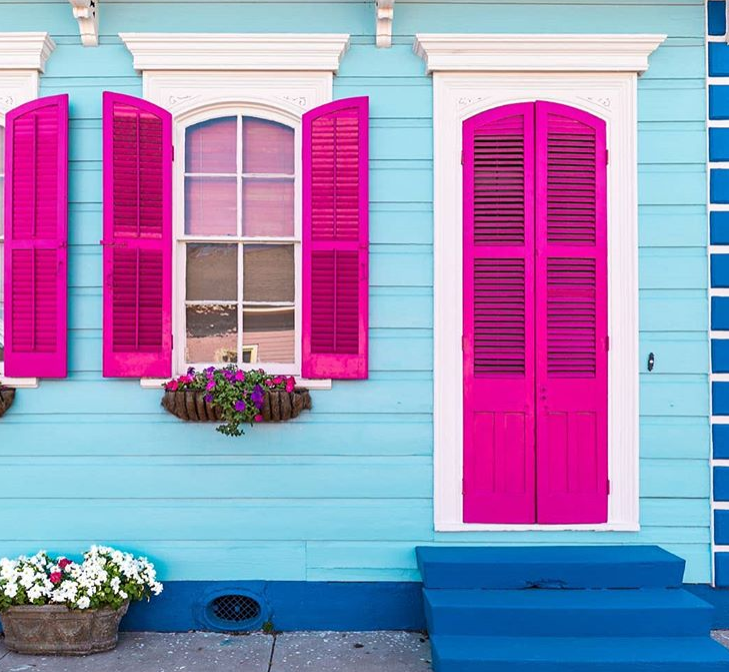*This post was updated in February 2019!
Mardi Gras may be over, but the parades are still rolling!

The St. Patrick's Day Parade might just seem like an excuse to keep the party going, but the Irish have long played an important role in the city of New Orleans, so the holiday and it's celebrating are not only a time for revelry, but a time to celebrate the unique Irish heritage in New Orleans.
New Orleans’ Irish Heritage
New Orleans has always held an appeal to the Irish due to its Catholic traditions and safe harbor for anti-British sentiments. Fleeing British persecution, the earliest Irishmen came to the city with the French and Spanish, landing in New Orleans at the end of the 1700s. Immigrant numbers drastically increased in the early 1820's as Irish immigrants were driven from their homeland due to famine.
As New Orleans was a thriving port city, Irish immigrants often found cheap passage to the city. Leaving Europe, American cotton ships unloaded their cargo in Liverpool and captains needed to load their holds up with human ballast for the return trip. Traveling conditions, needless to say, were far from ideal.
Once in New Orleans, living conditions for the thousands of Irish immigrants were also far from ideal. Poor and living in slums, the Irish were particularly susceptible to a series of epidemics that periodically swept the city and many Irish labored on the New Basin Canal, a dangerous project which claimed thousands of lives. Still immigrants came to seek opportunities in New Orleans. Many settled into the riverfront neighborhood on the south side of Magazine Street from the Garden District, in what was originally the city of Lafayette. Today, it is called the Irish Channel and home to the New Orleans St. Patrick's Day Parade.
Notable Irish Landmarks in New Orleans

Those Irish immigrants left lasting marks on the city and many Irish points of interest are still around today. For example, the Gallier House on Royal Street. James Gallier, Sr., and his son James Gallier, Jr., were Irish architects who designed many landmark buildings in the New Orleans, including Gallier Hall on St. Charles Avenue. Gallier House in the French Quarter was designed by James Gallier, Jr., to serve as his residence, and it’s now a charming museum.
Another landmark of Irish influence is the Margaret Haughery statue on Prytania Street. Margaret Haughery was a destitute Irish immigrant who became a prominent New Orleans businesswoman and philanthropist. In commemoration of her good works and impact on the city, this statue of her was erected and it is reported to be the first US statue to honor a woman.
And of course one of the most iconic Irish cultural landmarks to New Orleans is St. Patrick's Church. Founded in 1833, this Gothic church is a now National Historic Landmark and is still the center of Irish life in the city as it was once was for many immigrants.
St. Patrick’s Day celebrations
The New Orleans St. Patrick's Day celebration will begin with mass held at St. Mary’s Assumption Church at noon, and the parade will follow immediately after. About 1,400 marchers are expected, and about 30 floats will line up toward Tchoupitoulas Street. Riders throw cabbages, carrots and potatoes (in addition to green beads and Moon Pies) to the crowds.
Many Magazine Street bars host block parties, including Parasol's Bar, located in the Irish Channel. On both Saturday, March 11, 2017 and Friday, March 17, 2017 green beer, local flavors and even -leprechauns- crowd the area from 10 a.m. to 8 p.m. Adorn your green and hit the streets for another great New Orleans celebration!
If you enjoyed this post, let us know in the comments section below and share with someone who might enjoy it as well. Follow us on social media and listen to the Solo Travel Talk Podcast for more affordable luxury solo travel tips, tricks, stories and advice. Click on the links below!
New Orleans is host to many unique festivals and events throughout the entire calendar year. With so many options, it’s hard to sort through them all, so Astrid Solo Travel Advisor compiled a list of recommendations for the most solo-friendly New Orleans happenings in 2019:
If you find yourself traveling solo to New Orleans during the Holiday Season and you are still looking for the perfect gift for the lucky guy in your life? Shop local this holiday season and give him a gift from a New Orleans brand or boutique!
Reveillon (REH-vee-on). A Creole tradition from the mid-1800s, dozens of New Orleans' finest restaurants serve up decadent four-course holiday feasts with all the trimmings through the month of December.
Shop local this holiday season and stuff your stockings form local artisans, boutiques, and brands!
Staying in shape this time of year is hard, but luckily New Orleans is home to some of the best jogging and running trails, fitness studios, and gyms. Whether you’re a local trying to change up your fitness routine or you’re a visitor wanting to drop in on a class, there’s something for everyone here.
Looking for the best New Orleans Happy Hours when traveling alone to the Crescent City? Here is a list of 5 of New Orleans’ favorite restaurant hangouts from classic to cool casual that are well suited for the solo traveler
If you are traveling solo to New Orleans during Thanksgiving and want to eat a traditional Holiday meal at a solo friendly restaurant, here is my list of the 11 Best Restaurants in New Orleans for a memorable Thanksgiving meal.
Known for its live music, local art and good eats, Frenchmen Street in New Orleans should be a must on every solo traveler’s list!
Second only to Mardi Gras when it comes to costumes, revelry, and an overall good time, Halloween in New Orleans is the most haunting party of the year! Plan to spend your next Halloween as a solo traveler in New Orleans, the most Haunted City in America
Be smart, be aware, and be safe when traveling alone in New Orleans. If solo travelers do these things and follow the safety tips we've detailed for you, solo female travel in New Orleans should be a piece of cake.
A hotel can make or break a solo traveler's trip to New Orleans. Taking into account safety, location, and price, we’ve put together a list of the best hotels in New Orleans for the female solo traveler.
New Orleans celebrated its 300th birthday in 2018 which means centuries of recipes and historic restaurants that make the Crescent City a great food city for foodies traveling alone, as a couple or in a group.. Here are the three oldest and best restaurants in New Orleans which are all located in the historic French Quarter neighborhood.
On #NationalTacoDay there are plenty of places dine and celebrate in New Orleans as a solo diner. Discover here our top four taco restaurants in the Crescent City that are well-suited for someone traveling and dining alone.
The new terminal at the New Orleans International Airport(MSY) is set to open in 2019. Top New Orleans Restaurants and retail outlets will fill the gorgeous new architectural structure making the solo traveler’s experience in New Orleans memorable.
Fall is a great time to travel alone to New Orleans because there are lots of fun things to do. Solo travelers will have a hard time feeling lonely if you attend one of these 5 fun fall festivals.
Don’t miss one of the best New Orleans free festivals, the Fried Chicken Fest, when you are considering traveling to the Crescent City. Celebrity chefs, famous musicians, lots of delicious fried chicken and more awaits the lucky solo traveler who makes it a point not to miss this fun festival in the Big Easy.
A day in New Orleans is not nearly enough, but if you're here traveling solo for a layover or just passing through, 24 hours is enough time to see, eat, and dance your way through key things to do in the Crescent City. Here is Astrid Solo Travel Advisor's guide for a day trip to the Big Easy.
One of the South's most recognized thoroughfares, Magazine Street street is a six-mile journey filled with nearly every type of shop, restaurant and bar imaginable. If you’re looking for things to do on your next solo trip to New Orleans, check out this list of our favorite stops on the iconic Magazine Street.
In a city filled with James Beard winners and classic culinary institutes, a solo traveler might not think that New Orleans had any more room for new, exciting restaurants. Think again! Here is our list of the 5 trendiest new eateries in the Crescent City. Yum!
Get ready for a good, old fashioned New Orleans block party! Sponsored by Whitey Bank, Whitney White Linen Night is a chance for the Warehouse District, which has distinguished itself as being New Orleans's art epicenter, to show off NOLA’s thriving art scene.
We all need to eat, but some people love the food experience more than others. Foodies have a particular interest in what they eat and seek out unique dishes and experiences no matter where they are traveling. Here are three American food meccas that will satisfy anyone traveler - solo or not - looking for interesting food adventures.
During the month of August, experience cuisine that delights your palate and is an integral part of the history and culture of New Orleans. This annual culinary tradition features specially priced prix-fixe lunch, dinner and brunch menus, all at an incredibly affordable price!
Longer trip planning takes a different approach when traveling alone. On the new episode of my solo travel podcast, Solo Travel Talk, I use the backdrop of New Orleans to explore how to head out for a trip of either multiple weeks or months. Don’t miss my long term trip planning tips for the solo traveler; Tune In!
Airbnb Experiences are excursions or other interesting activities designed and led by local hosts, giving solo travelers unique access into the fascinating places and activities in a city. Learn more about the many New Orleans Airbnb Experiences that are available to people traveling alone to the Big Easy that choose Airbnb for their accommodations.
New Orleans has so much more to offer than its tourist attractions. Visiting NOLA and looking for something to do that is a little off the beaten path? Check out Algiers Point, the best kept secret in New Orleans and its second oldest neighborhood!
Only have a short time to visit New Orleans when traveling alone? I’ll help you maximize your solo travel no matter how much time you have in the most fabulous southern city in the US.. Using New Orleans as my example, I give you lots of travel tips on how to maximize your time as a solo traveler in any city, even if you have just a few hours.
While New Orleans in July is very hot, airfare and hotel rates are the cheapest in the summer. Plus, there is a ton going on! Here’s a list of a few of our favorite festivals and events happening in New Orleans in the steamy month of July!
With magic around every corner, New Orleans is one of the most Instagram-able cities in the world. We've compiled a list of our favorite New Orleans Instagrammers to inspire the solo traveler to make New Orleans their next solo adventure destination.
Looking for the hottest new restaurant to dine in when traveling solo to New Orleans? Saba, is award-winning chef, Alon Shaya’s, newest restaurant specializing in Isreali food. Yum!






























Every female solo traveler is different when it comes to exploring a city alone at night. Some are reluctant to leave the comfort of their hotel, others are eager to hit the town, and some want to be out and about, but don’t want to drink alcohol. Our list of 7 things to do at night as a solo traveler in New Orleans has something to suit every preference!